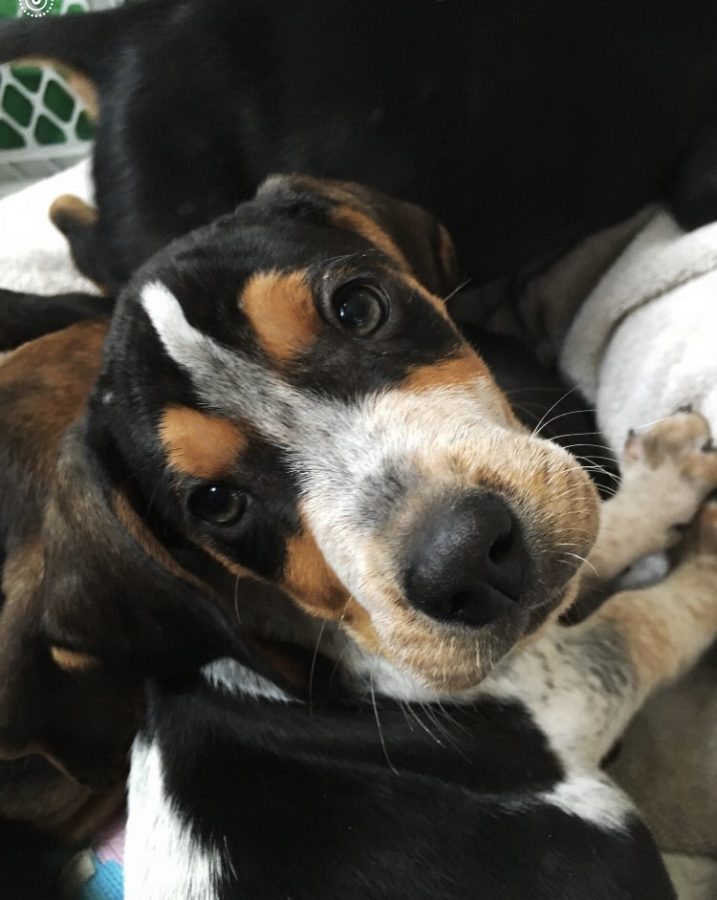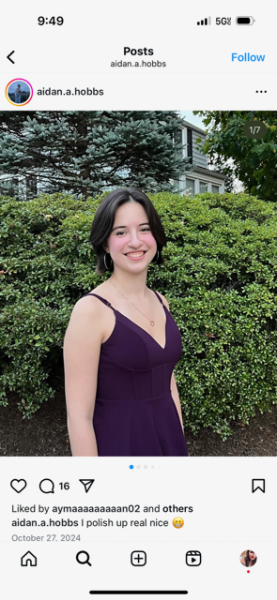Arlington community fosters pets
Purring kittens, sleeping puppies and squealing guinea pigs make up some of the many furry friends that enter the homes of those that open up their hearts and foster.
According to the Animal Welfare League of Arlington’s (AWLA) Foster Program Coordinator Veronica Wheeler, fostering is when a person takes in a shelter animal for a period of time, and provides it a safe, comfortable loving environment until it is adopted. The main goal of fostering is to get the animal out of the shelter.
“Even though at AWLA we have a very nice facility and loving, caring and wonderful staff members, no matter what, it will still be scary for pets, especially given the circumstances of their coming to us,” Wheeler said. “They may have just lost their person or their family. It’s a brand new environment with lots of noises and smells, and it’s scary because they don’t really know what’s going on. When we put them in a foster, we’re replicating a home environment and making them as comfortable as they possibly can be until we find their new forever home.”
Fostering also does more than get an animal out of a scary environment; it helps to save the lives of other animals.
“Every time there’s a free kennel space [in the shelter], we can bring another animal in,” Wheeler said. “If all of our kennels were full, we would be like the shelters years and years ago that were forced to euthanize. There are still shelters that exist like that, but not in urban environments like ours, because the fostering model is something that really has grown.”
This growth is obvious, as Wheeler said in the past year more than 2,000 people have signed up to foster from AWLA, which is a massive change from the shelter’s previous numbers — but not a surprising one.
“Generally speaking, I believe that people are understanding now more than ever [due to quarantine] of the benefits of companionship with an animal,” Wheeler said. “[Excluding the kitten college], we had maybe only 25 percent of our animals going out to foster care previously. Now, we’re near 75 percent.”
The shelter, which fosters out small companion animals, dogs and cats, aims to keep this percentage even once the pandemic is over.
“We realize now that we have the volunteer base to make it so the animals don’t have to sit in a kennel, they can be out in a home environment until they get adopted,” Wheeler said. “It’s really the fosters and volunteers outside of the building that made it so that we can help so much with the community and help other organizations. We would have to turn away members of the public that might have fallen on hard times, and need to surrender their animals and we wouldn’t be able to transfer animals from organizations like Human Society International.”
Some examples of transfers AWLA has done in the past have been from dog meat farms in Korea, various natural disasters and animals from the Beirut explosion. However, they also receive and foster animals from more local organizations as well.
“We have dedicated rescue groups that we work with [to transfer animals in Southern Virginia and West Virginia ] … which is where the majority of transferred animals are coming from,” Wheeler said. “We also have two counties that we transfer from in West Virginia where sadly when the shelter gets too crowded, they either have to make the decision to euthanize for space, or they have to turn local members of the public away if they want to surrender their animals.”
AWLA fosters also play a large role in helping them transfer out animals from those shelters, even if the animals do not belong to AWLA itself.
“There had been a hoarding case recently that happened with some Great Danes,” Wheeler said. “One of the shelters we transfer from was overseeing the case, but they asked me if they could use some of our foster families. Even though these dogs weren’t technically at AWLA, we were still helping other dogs in the community through that rescue group.”
Many of the animals up for foster at AWLA do come from difficult backgrounds, but none that go out to foster are dangerous.
“A lot of times with dogs that need to be helped with their behavior, people assume that you’re bringing home an aggressive animal,” Wheeler said. “It actually is that we might just be trying to bring them out of their shell and teach them more confidence, or, you know, a large dog that was always allowed to pull on the leash, we’re trying to teach them proper leash manners, that kind of thing… A lot of it is helping our adult animals live a more comfortable life [which makes it easier for their future owner].”
To some, fostering may seem like a challenging or impossible endeavor. However, many Arlington Public School (APS) students partake in it, including Yorktown high school sophomore Hana Christensen. Christensen fosters dogs from Lost Dog Rescue, where she adopted all of her four current dogs and continues to foster more from.
“Our maximum is six or seven dogs in the house [including our own].” Christensen said. “We’re constantly fostering dogs in and out, sometimes for a few weeks and sometimes it’s just for the weekend.”
This may sound overwhelming to some, but Christensen said otherwise.
“Depending on the type of animal and their personality, you can have very different experiences,” Christensen said. “It doesn’t uproot your life, it’s just more like minor inconveniences like feeding them, walking them, or things you might not normally do, but it’s not necessarily hard.”
Lucy Flannery-Goodman, who is also a sophomore at Yorktown high school, agrees. Flannery-Goodman fosters puppies from Lucky Dog Rescue, an organization that is solely foster-based and operates without a shelter location.
“There can be really challenging parts where it is really frustrating at times and there’s just a lot going on, or all of the puppies are peeing and pooping everywhere,” Flannery-Goodman said. “Then there’s other times where they fall asleep on you and everything in that moment is so perfect.”
Flannery-Goodman has seen many puppies benefit from foster care in her home.
“Sometimes they’re nervous when they first get to us, so the most rewarding part is when they trust you,” Flannery-Goodman said. “For some, when you reach over and try to pet them they’ll run away, but a few days later they’ll be the ones to come to you, and they’ll sit in your lap.”
Wheeler, who has also fostered, has seen many physical benefits as well. Wheeler once fostered a golden retriever puppy who had developed puppy pica, in which a dog eats anything that they can fit into their mouth. In this case, it was due to the puppy having been undernourished in his previous home. The dog ended up eating a string of Christmas lights, and had to have 18 inches of his intestine removed. Due to the costs, AWLA contacted the owner to have the puppy surrendered so that he could be provided with proper care.
“He had to go through behavioral therapy and learn to stop eating rocks or sticks outside, but now he’s in a wonderful loving home.” Wheeler said. “He doesn’t go around trying to eat anything, and he’s a big old, healthy, normal, golden retriever dog. But when we got him he had been in [what could have been] the last moments of his life.”
Ashley Kennedy, a sophomore at Washington-Liberty high school, also deals with vulnerable animals, these ones being kittens. Kennedy is a part of AWLA’s kitten college, in which she receives younger, more vulnerable kittens unlike those of the regular foster program and often fosters entire litters.
“It’s difficult for the shelter to take care of all of the little kittens, so people fostering helps out a lot,” Kennedy said. “It can be a little challenging at the start, but once you get used to it, it’s not too bad.”
Even though kittens may be small, Kennedy has seen them benefit from foster care as well.
“With all of the kittens, you can see them grow to like people and cats more,” Kennedy said. ”When they start out, they might be by themselves and might not have a mom, so they could be scared of people. By the end of that time, though, they’ll always be really sweet and will want to be around other humans.”
Fostering may appear difficult for those with other pets, but Kennedy, Christensen and Flannery-Goodman have all made it work in their situation. For Flannery-Goodman, who owns two dogs, the decision was easy.
“Our older dog gets kind of protective of our house [when there are other dogs in it], but with puppies she’s not because they’re so rambunctious, little and cute,” Flannery-Goodman said.
Christensen also had a similar situation, in which her dog only tolerated small dogs, therefore that was the group they went for. Kennedy, who has two adult cats, went with kittens as she felt that her cats would be able to help the kittens with socialization and finding forever homes.
“Normally, we try to get them to interact with each other just in case their future adopters have cats and want to adopt a kitten [and have them get along well],” Kennedy said.
However, it is not necessary to have a pet or to know how to specifically take care of one in order to foster.
“We’ve had plenty of foster families come through that had never owned an animal before; we’re here to educate and support them as much as they need throughout the process,” Wheeler said. “The staff on site helps with supplies and sending the animal back and forth, while remote volunteers like myself are constantly supporting by answering questions and teaching them about the adoption process, or handling medical issues that might come up.”
Supplies also should not be an issue if one decides to foster at AWLA.
“We provide everything,” Wheeler said. “It’s all donation-based, so it’s awesome if a foster can provide some of the materials, but you are not prevented from fostering if you don’t have the materials. We have everything and we can provide supplies or resources or anything that is needed really to help get a foster started.”
Signing up to foster at AWLA is just as easy as getting started. To sign up, all one must do is go to the organization’s website, awla.org, go to the programs tab, click foster, and fill out a foster interest form. Before and after this, Wheeler plays an important role.
“We present all the information to the fosters and then they get to decide what kind of fostering they want to do,” Wheeler said. “We reach out to them based on our needs, and try to get them sent home with the type of animal that fits them when it becomes available.”
However, the steps taken until an animal can be fostered are a bit more complex, and depending on the circumstances, most foster families will not immediately receive a foster animal after signing up. Once an animal enters the shelter, several processes must occur.
“When we receive a dog, for example, they get a whole [medical] workup, various enrichment is brought to them, they are set up in their kennel and they are settled for the time being,” Wheeler said. “Then, my team is already working to try and place that dog by sending out emails and reaching out to those who are eligible.”
Once the animal is placed in its foster home and has no more behavior, medical needs or issues, the animal will be placed up for adoption. However, more steps occur until the animal will go to its forever home. This includes foster families creating a foster email address that will be shared to the website, as well as a description of their foster animal and images of it.
“Foster families will be having virtual meet and greets, on whatever platform they want to use.” Wheeler said. “Their job is to show off the animals and their personality and everything. Fosters don’t have to deal with vetting or any medical history, that is for the adoption counselors. The foster’s job is simply to show off their animal. Once that’s done, the adoption team then will schedule a meeting [with the adopters], bring the animal back to the shelter, and then they can go to their forever home.”
The goal of this, according to Wheeler, is to have the animals adopted as quickly as possible, but the timing heavily depends on the type of animal and its age.
“If they’re available and we’re promoting them actively, I would say that no one sits around in foster-care for longer than a month,” Wheeler said. “For an adult cat it usually ranges anywhere between two to four weeks, and for adult dogs around one to two weeks. As soon as the kittens and puppies are spayed and neutered, they get adopted immediately. For small companion animals, it will usually be two to four weeks.”
Many may hesitate to foster because the foster animal does not stay forever. This is an issue Christensen has dealt with, but said that it got better over time.
“You could get attached, so it’s hard, but now that we’ve done it so many times it’s easier,” Christensen said. “You have to think, ‘oh, if you take care of them their spirits will rise, and maybe their personality will show up more and they’ll feel happier.’ You can also reach out to other people [who might want to adopt them], and you’ll know all about the dogs and be able to help them find a good home.”
To Wheeler, the reward is also higher than the risk.
“I think it’s 100 percent worth it and totally rewarding,” Wheeler said. “People get addicted to it, but it is hard. The first time I would say is always the hardest for everyone because you have created that bond with the animal and you really just want to see them live the best life possible. So it’s hard to say goodbye. What makes up for it is how rewarding it feels, and knowing that once you’ve found that animal their home, you can help another one, and just keep it going. That way, you can help as many animals as physically possible.”
The adoption process can also be enjoyable for the foster family as well, according to Flannery-Goodman.
“A lot of our foster situations are pretty similar, but some families you just know are going to be perfect [for the dog], and if they have kids and they come in all excited, it’s just the best,” Flannery-Goodman said.
With the ongoing cycle of foster animals, almost all foster families also take a break before they receive their next foster animal(s), including Kennedy’s.
“Normally we take a little break, because it’s a lot of work, as we’re normally dealing with five cats since we have our own and then the kittens,” Kennedy said. “We take a break to clean up all the stuff that they were living in, and sometimes we also have to wait a long time until there’s kittens available for us to foster, but normally it’s two or three weeks in between.”
Despite the hard work fostering takes, Christensen said she does not plan to stop.
“You’re saving the dogs that you foster, while also allowing other dogs to be helped as well,” Christensen said. “A lot of these dogs had really hard lives before coming to these shelters. Fostering helps get more dogs out of those situations and then they get to live somewhere and be happy forever.”
Along with the obvious benefits of adorable animals, Flannery-Goodman said that she herself has also benefited from fostering.
“Your responsibilities change, and you learn how to handle situations better, as well as how to care for what you’re given,” Flannery-Goodman said. “In general though, it just makes you happier. You’re fostering puppies and seeing them go to such nice homes and knowing that there are so many nice people out there that want them.”
Wheeler would agree; the impact that fostering leaves on a foster family is a great one.
“Fostering is good for the soul, a hundred percent,” Wheeler said. “It’s amazing to be able to give this other being an opportunity to thrive. Knowing the impact that you’ve made, even if it’s a few days or a few weeks, the impact that you’ve made on their lives and then having them find their forever home… it’s heartwarming.”
However, if one cannot foster, there are other ways to help animals in the community.
“You can volunteer and donate, even if that’s making enrichment toys for some of our dogs or cats,” Wheeler said. “We can always use enrichment items. We also have community programs, like the kids camp and things like that. So if you can’t foster right now, there’s other ways to get involved with the shelter. And then when you’re able to foster, we’ll get you started.”
For those undecided, Wheeler said there is only one thing to do:
“You’ve got to try it,” Wheeler said. “Give it a chance.”










